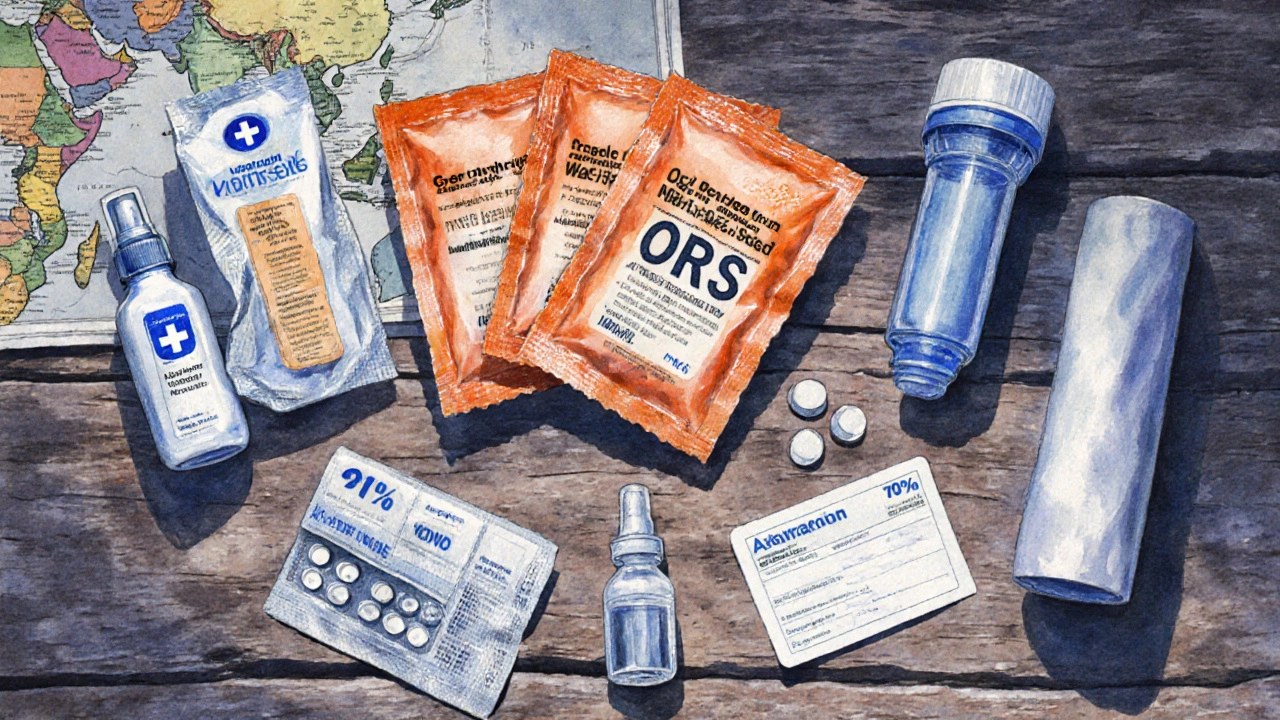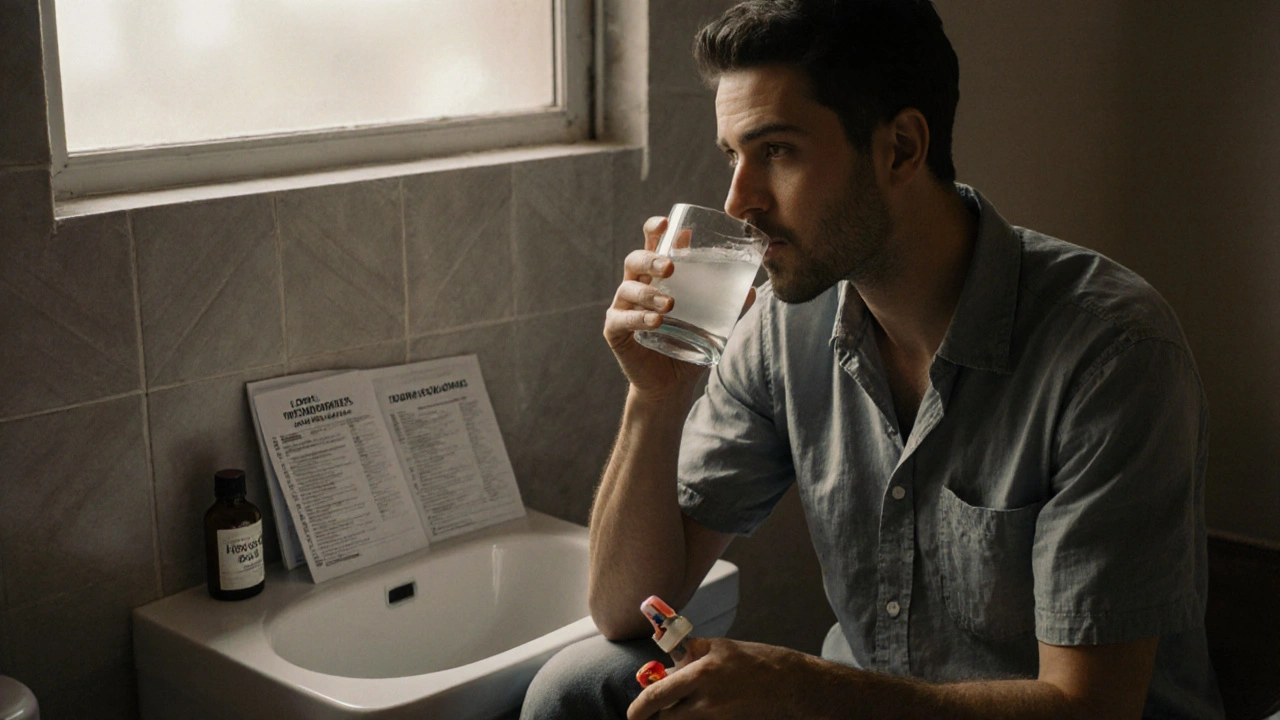Water Purification Calculator
Calculate Your Water Purification Needs
Determine exactly how much water treatment you need for your trip to avoid traveler's diarrhea. Based on WHO recommendations for safe water consumption while traveling.
Enter your trip details above to calculate your exact water purification requirements.
Note: The WHO recommends 2-3 liters of clean water per day for adults during travel, but individual needs vary based on climate, activity level, and personal factors.
Few things ruin a vacation faster than a sudden bout of stomach pain, cramping, and frantic bathroom trips. That’s the classic picture of traveler’s diarrhea, a mild form of gastroenteritis that strikes millions of tourists each year. The good news? Most cases are preventable with a few smart choices before and during your trip.
Key Takeaways
- Know the common culprits: unsafe water, raw foods, and poor hand hygiene.
- Vaccinate against typhoid and consider an oral cholera vaccine for high‑risk regions.
- Carry a lightweight travel health kit that includes oral rehydration salts, a broad‑spectrum antibiotic, and a probiotic.
- Use water purification methods (filters, chlorine tablets) and treat all drinks that aren’t bottled or boiled.
- If symptoms appear, start rehydration immediately and seek medical care if you have fever, blood in stool, or dehydration signs.
What Exactly Is Traveler’s Diarrhea?
Traveler's Diarrhea is a short‑term gastrointestinal infection that typically lasts 3‑7 days and is caused by ingesting contaminated food or water. It falls under the broader category of gastroenteritis, which refers to inflammation of the stomach and intestines that can be triggered by bacteria, viruses, or parasites.
Most cases are bacterial-often Escherichia coli (ETEC)-but viral agents like norovirus and parasites such as Giardia can also be responsible. The symptoms range from mild cramping and loose stools to severe dehydration, especially in older travelers or those with compromised immunity.
Spotting the Biggest Risk Factors
Understanding where the danger hides helps you dodge it. Here are the top three triggers:
- Unsafe water: Tap water, ice cubes, and even uncooked vegetables washed with contaminated water can harbor pathogens.
- Street food and buffets: Foods left at ambient temperature for hours allow bacteria to multiply.
- Poor hand hygiene: Travelers often skip hand‑washing after using public restrooms or before meals.
Geographically, regions with limited sanitation infrastructure-parts of South Asia, Sub‑Saharan Africa, and Central America-show higher incidence rates. According to the World Health Organization, about 30‑40% of travelers to these areas experience some form of diarrhea.

Pre‑Travel Prevention Checklist
Start your defense plan months ahead of departure.
- Vaccinations: Get the typhoid vaccine (injectable or oral) if you’ll be eating local street food. In coastal regions of South Asia, an oral cholera vaccine can add extra protection.
- Consult a travel clinic: A doctor can prescribe a “stand‑by” antibiotic such as azithromycin (500mg daily for three days) for severe cases.
- Pack a travel health kit: Include oral rehydration salts (ORS), a probiotic (e.g., Lactobacillus rhamnosus GG), and a small bottle of 70% hand sanitizer.
- Upgrade your water safety gear: Bring a portable filter (0.2µm pore size) or a pack of chlorine dioxide tablets for treating tap water.
- Research local food customs: Identify reputable restaurants, avoid raw salads, and prefer foods that are cooked fresh and served hot.
Smart Packing List for Gastro‑Protection
The lighter the kit, the more likely you’ll actually use it. Here’s a streamlined list that fits in a small toiletry bag:
- Oral Rehydration Solution (ORS) packets - 6‑8 packets (each reconstitutes to 1L of fluid with 90mmol/L sodium and 20mmol/L potassium).
- Prescription azithromycin or ciprofloxacin (consult doctor first).
- Probiotic capsules - 30‑day supply.
- Water purification tablets (chlorine dioxide) - 50tablets.
- Compact water filter or UV purifier.
- Alcohol‑based hand sanitizer (minimum 60% ethanol).
- Anti‑diarrheal medication (e.g., loperamide) - use only for mild, non‑bloody diarrhea.
First‑Aid Steps If Symptoms Strike
When the first rumble hits, act fast to keep dehydration at bay.
- Start rehydration immediately: Mix one ORS packet with clean water and sip continuously. Aim for 200-400mL per hour.
- Assess severity: Mild cramping without fever can be managed at the hotel. Presence of fever >38.5°C, blood in stool, or inability to keep fluids down calls for medical attention.
- Take a probiotic (one capsule) to help restore gut flora.
- Consider an antibiotic only if symptoms persist beyond 48hours or if you have high‑risk factors. Follow the prescribed regimen - usually 500mg azithromycin once daily for three days.
- Avoid anti‑diarrheal meds if blood or mucus is present; they can trap pathogens.

When to Seek Professional Care
Most tourist‑related gastroenteritis resolves on its own, but watch for red flags:
- Fever lasting more than 48hours.
- Severe abdominal pain or vomiting that prevents fluid intake.
- Visible blood or black/tarry stools.
- Signs of dehydration: dizziness, dry mouth, reduced urine output, or rapid heartbeat.
In these cases, locate the nearest clinic or hospital. Many travel destinations have English‑speaking staff in international hospitals. Carry a copy of your vaccination records and a list of any prescription antibiotics you’re carrying.
Quick Comparison of Common Over‑the‑Counter Options
| Product | Form | Typical Dose | Pros | Cons |
|---|---|---|---|---|
| Oral Rehydration Salts (ORS) | Powder packet | 1packet per L of water | Restores electrolytes quickly | Requires clean water source |
| Loperamide (Imodium) | Tablet | 2mg after first loose stool, then 2mg after each subsequent (max 8mg/24h) | Reduces stool frequency | Should not be used with blood/mucus in stool |
| Probiotic (L. rhamnosus GG) | Capsule | 1billion CFU daily | Supports gut flora balance | Effect takes 1-2days to appear |
| Azithromycin (prescription) | Tablet | 500mg once daily for 3days | Effective against most bacterial causes | Requires doctor’s prescription, potential side effects |
Final Checklist Before You Go
- Confirm vaccinations (typhoid, cholera, hepatitisA) are up to date.
- Obtain a prescription for a standby antibiotic if recommended.
- Pack ORS, probiotic, hand sanitizer, and water purification tools.
- Download a reliable translation app for food‑safety questions.
- Print a list of local hospitals and emergency numbers.
Frequently Asked Questions
Can I prevent traveler’s diarrhea by only drinking bottled water?
Bottled water is a solid start, but ice cubes, uncooked fruits, and sauces can still be contaminated. Combine bottled water with diligent hand‑washing and safe food choices for the best protection.
Is it safe to take antibiotics without a prescription while traveling?
Self‑medicating can lead to resistance and side‑effects. Always get a doctor’s prescription. In many countries, a short course of azithromycin is the preferred standby option.
How much ORS should I consume each day?
Aim for at least 2-3L of ORS‑reconstituted solution per day if you have diarrhea. Adjust based on urine output and thirst.
Do probiotics prevent traveler’s diarrhea?
Probiotics can reduce the duration and severity but are not a guarantee. They work best as a complement to other preventive measures.
When should I use loperamide?
Only for mild, non‑bloody diarrhea when you need to limit trips to the bathroom. Avoid if you have a fever, abdominal cramps, or blood in stool.


Roberta Giaimo
October 14, 2025 AT 22:00Great overview! I always make sure to pack a compact filter and a few purification tablets, just in case the local water isn’t trustworthy. Hand‑sanitizer is a must‑have, especially after using public restrooms. Remember to re‑hydrate with ORS packets if you start feeling off‑track – they’re a lifesaver. :)
Tom Druyts
October 17, 2025 AT 09:18Love the energy in this guide! It’s exactly the kind of boost you need before a big trip – pack smart, stay hydrated, and keep that positive vibe rolling. You’ll crush any gut bugs that try to ruin your adventure.
Julia C
October 19, 2025 AT 20:35This article reads like another corporate attempt to sell you on expensive gear while ignoring the real threat: the hidden agenda of governments to keep travelers dependent on commercial products. The facts about unsafe water are obvious, yet the piece drags on with fluff. If you’re truly concerned, just bring a cheap charcoal filter and stop listening to the hype. The world’s a mess, and we’re all vulnerable.
Brooke Bevins
October 22, 2025 AT 07:53Exactly, Julia. While the fear‑mongering can be over the top, the core advice is solid – treat everything that isn’t boiled water. Your health is paramount, and a reliable filter or tablets can save you from an embarrassingly long bathroom break. Keep that fire in you, but stay safe. :)
Vandita Shukla
October 24, 2025 AT 19:11Let me clarify a few points that many travelers overlook: first, not all “portable” filters meet the 0.2 µm standard; you must verify the specifications before purchase. Second, chlorine dioxide tablets lose potency after six months, so check the expiration date. Finally, remember that ice cubes in cocktails are often made from tap water – refuse them outright.
Susan Hayes
October 27, 2025 AT 05:28Vandita, your checklist is useful but it forgets the bigger picture: American travelers should trust American‑made gear because it adheres to stricter standards. Foreign products often cut corners, putting us at risk. Stick with reputable US brands for filters and antibiotics. Our health shouldn’t be compromised by cheap imports.
Deepak Bhatia
October 29, 2025 AT 16:46Thanks for the practical steps. I always carry a small bottle of hand sanitizer and a couple of ORS sachets in my daypack. If I feel any rumbling, I sip the ORS right away and avoid heavy meals until it settles. Simple habits make a big difference.
Zackery Brinkley
November 1, 2025 AT 04:04Deepak, that’s spot on. Think of it as a routine: water filter, hand‑wash, ORS on standby. Treat every sip like a small victory over potential germs. You’ll finish your trip feeling great, not miserable.
Luke Dillon
November 3, 2025 AT 15:21Appreciate the calm tone here. When you’re on the road, it’s easy to panic, but keeping a level head and following the checklist will keep you in control. Stay hydrated, stay prepared, and enjoy the journey.
Elle Batchelor Peapell
November 6, 2025 AT 02:39Exactly, Luke. It’s fascinating how a simple act like sipping treated water can feel like a philosophical ritual, a reminder that we’re constantly negotiating with unseen microbes. The mind‑body connection becomes evident when a healthy gut lets you explore new cultures without distraction.
Jeremy Wessel
November 8, 2025 AT 13:56Pack a filter and ORS; you’ll thank yourself later.
suresh mishra
November 11, 2025 AT 01:14Jeremy, that succinct advice hits the mark. For anyone reading, just remember the filter must be rated for viruses, not just bacteria.
Courtney The Explorer
November 13, 2025 AT 12:32Patriots, do not be fooled by foreign manufacturers who cut corners on filtration efficacy!!! Our nation’s health depends on using certified, domestically‑produced water treatment solutions; only such gear guarantees safety!!!
Ashleigh Connell
November 15, 2025 AT 23:49While I respect the enthusiasm, let’s keep perspective. Quality matters more than origin, and a well‑researched foreign filter can be just as reliable. The goal is to stay healthy, not to champion a brand.
Erin Knight
November 18, 2025 AT 11:07Honestly, this guide feels like a recycled marketing brochure. The “one‑size‑fits‑all” approach ignores regional variations in pathogen prevalence. A more nuanced, data‑driven recommendation would have been preferable.
Kavita Jadhav
November 20, 2025 AT 22:25Erin, I hear your concerns, but the core advice-treat water, carry ORS, and stay vigilant-remains universally solid. Tailoring specifics can be done on the ground, yet the baseline safeguards are non‑negotiable.
Tony Halstead
November 23, 2025 AT 09:42Traveling abroad is, in many ways, a microcosm of life’s larger journey-both are riddled with unseen hazards, unexpected challenges, and moments of profound discovery. When you step onto a foreign shore, you’re immediately confronted with a new microbial ecosystem, one that has evolved in tandem with the local climate, cuisine, and cultural practices. The human gut, a remarkably adaptable organ, can be both a resilient ally and a vulnerable gateway, depending on how we equip ourselves. That’s why a portable water filter, rated to remove viruses as well as bacteria, is not merely a gadget but a lifeline, a portable shield against the invisible.
Equally important is the principle of redundancy: having both a filter and a supply of chlorine‑dioxide tablets ensures that if one method fails, the other can pick up the slack. This dual‑strategy mirrors the ancient adage of “prepare for the worst, hope for the best.”
Hydration, however, is not just about volume; it’s about electrolyte balance. Oral Rehydration Salts (ORS) provide the precise sodium‑potassium ratio needed to combat dehydration that stems from diarrheal loss. In the field, a single ORS packet dissolved in a liter of treated water can make the difference between a quick recovery and a prolonged decline.
Beyond the physical tools, mindset plays a pivotal role. Travelers who approach each meal with cautious curiosity-scrutinizing the source of ice, asking vendors about cooking practices, and favoring foods that are freshly cooked-tend to experience fewer gastrointestinal setbacks. This deliberate vigilance does not mean living in fear; it is a balanced dance between enjoyment and prudence.
Moreover, the psychological comfort of having a well‑stocked health kit cannot be overstated. Knowing that you possess a standby antibiotic (prescribed by a qualified clinician), a probiotic to restore gut flora, and a reliable water purification system can alleviate anxiety, allowing you to engage more fully with the culture around you.
In the event that symptoms do arise, the response should be swift: begin ORS rehydration immediately, maintain a log of fluid intake, and consider a short course of the prescribed antibiotic if bacterial infection is suspected. Avoid anti‑diarrheal agents when blood or mucus is present, as they can trap pathogens.
Finally, remember that after the trip, a brief post‑travel check‑in with a healthcare provider can catch lingering issues before they become chronic. In sum, the interplay of proper gear, educated habits, and a proactive health mindset creates a robust defense against traveler’s diarrhea, turning potential setbacks into mere footnotes in an otherwise enriching journey.
leo dwi putra
November 25, 2025 AT 21:00Wow, Tony, that reads like an epic saga! While the drama is entertaining, let’s not forget the simple truth: a good filter, some ORS, and common sense keep most of us out of the bathroom. No need for a novel when the checklist works.